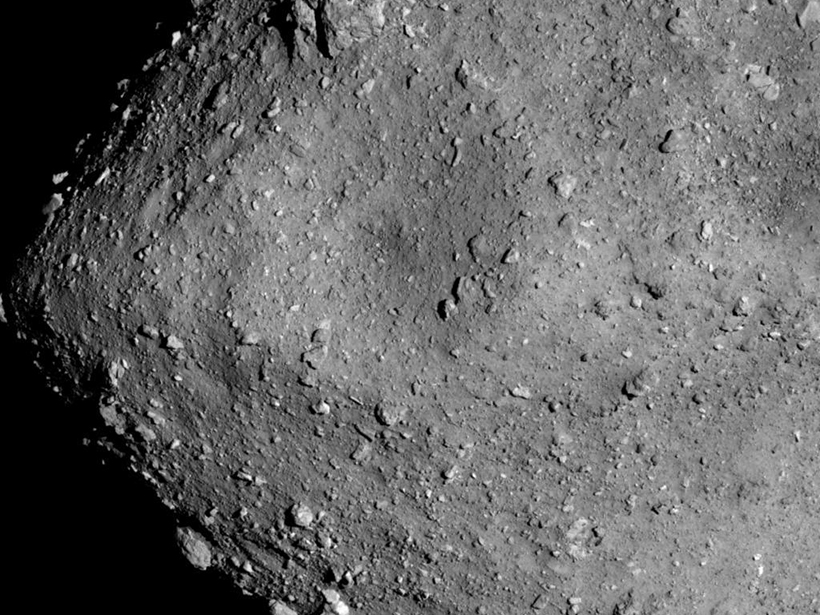Peering back in time over 4 billion years is hard, but asteroids lend a hand: These space rocks contain primordial material left over from the formation of the solar system.
Scientists have now analyzed high-resolution images of the surface of Ryugu, a near-Earth asteroid recently visited by the Hayabusa2 spacecraft. They found a surprising lack of dust, rocks compositionally similar to rare meteorites, and a landscape consistent with the space rock forming from a cataclysmic collision. These results shed light on how asteroids are assembled, information that’s valuable for planning asteroid deflection missions on Earth, the research team suggests. These results were reported last month in Science.
“This is the first time scientists are able to study boulders up close on a dark asteroid.”
It’s critical to learn more about the composition, surface, and interior of asteroids in the event that one of these objects is incoming toward Earth, said Lucille Le Corre, an astronomer at the Planetary Science Institute in Tucson, Ariz., not involved in the research. “This is the first time scientists are able to study boulders up close on a dark asteroid.”
Exploring a Dark World
In June 2018, the Japan Aerospace Exploration Agency’s Hayabusa2 arrived at Ryugu after a 3.5-year journey. The refrigerator-sized spacecraft paced the roughly 900-meter asteroid, both objects orbiting the Sun at tens of kilometers per second. In October of the same year, Hayabusa2 released a lander—the Mobile Asteroid Surface Scout (MASCOT)—toward Ryugu’s surface from an altitude of 41 meters. Thanks to Ryugu’s extremely weak gravitational acceleration (about 1/80,000 that of Earth), MASCOT fell for roughly 6 minutes before tumbling to a stop. Over the next 17 hours, until its batteries ran out, the lander snapped more than 90 images with its visual and near-infrared camera. (Light-emitting diodes provided illumination during Ryugu’s roughly 4-hour night.)
These images, which record features as small as 0.1 millimeter, confirm that Ryugu is a dark world. It reflects only about 5% of the light that shines on its surface. “You can compare it to very dark coal,” said Ralf Jaumann, a planetary scientist at the German Aerospace Center in Berlin and lead author of the new study.
MASCOT’s close-up images also revealed a mystery. They showed that Ryugu’s surface is free of dust, a big surprise given that asteroids are constantly bombarded by interplanetary dust particles. These tiny impacts, which pulverize and destroy the upper structure of rocks, produce debris.
“There should be dust,” said Jaumann.
He and his collaborators hypothesize that dust may sink into holes on Ryugu’s porous surface, effectively remaining hidden from view. Another idea is that the charged particles that constantly circulate through the solar system—the solar wind—create a magnetic field on Ryugu’s surface that causes dust to levitate. The dust then escapes from the asteroid because of the space rock’s weak gravity, the team suggests.
“Ryugu is some product of a violent process.”
MASCOT’s instruments also showed that the rocks that litter Ryugu’s surface—ranging in size from a few tens of centimeters to a few tens of meters—tend to fall into one of two categories. They’re either dark and rough or relatively bright and smooth, Jaumann and his colleagues found. “They have a different structure,” said Jaumann.
This finding implies that Ryugu may have formed from the collision of two different types of asteroids, the research team suggests. Or Ryugu’s inner and outer regions may have been originally composed of different types of material that got jumbled up after a cataclysmic impact by another body.
“Ryugu is some product of a violent process,” said Jaumann. It’s a rubble pile held together by weak gravity, so it’s important “not to destroy this pile of debris,” said Jaumann.
Ryugu’s rocks also contain inclusions, most of them smaller than 1 millimeter. On the basis of how these inclusions reflect light, some of them may contain olivine, a greenish mineral found in Earth’s crust and certain rare meteorites. Ryugu—or bodies like it—may therefore be the source of some of Earth’s meteorites.
In late 2020, scientists will get an even closer look at Ryugu. That’s when samples that Hayabusa scooped up from the asteroid’s surface will parachute down in the Australian outback. “Future laboratory studies of the samples from Ryugu will give us some clues about our solar system’s early history and formation,” said Le Corre.
—Katherine Kornei (@katherinekornei), Freelance Science Journalist
Citation:
Kornei, K. (2019), Nearby asteroid is mysteriously devoid of dust, lander reveals, Eos, 100, https://doi.org/10.1029/2019EO132275. Published on 05 September 2019.
Text © 2019. The authors. CC BY-NC-ND 3.0
Except where otherwise noted, images are subject to copyright. Any reuse without express permission from the copyright owner is prohibited.

